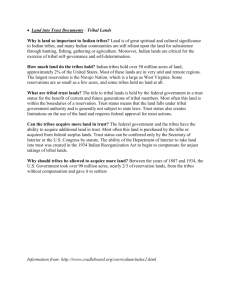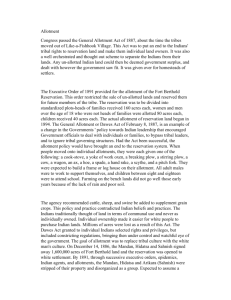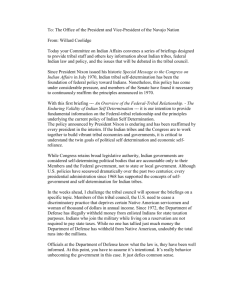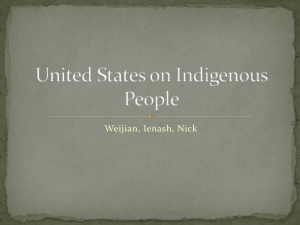Montana Indians - Columbia Falls Schools
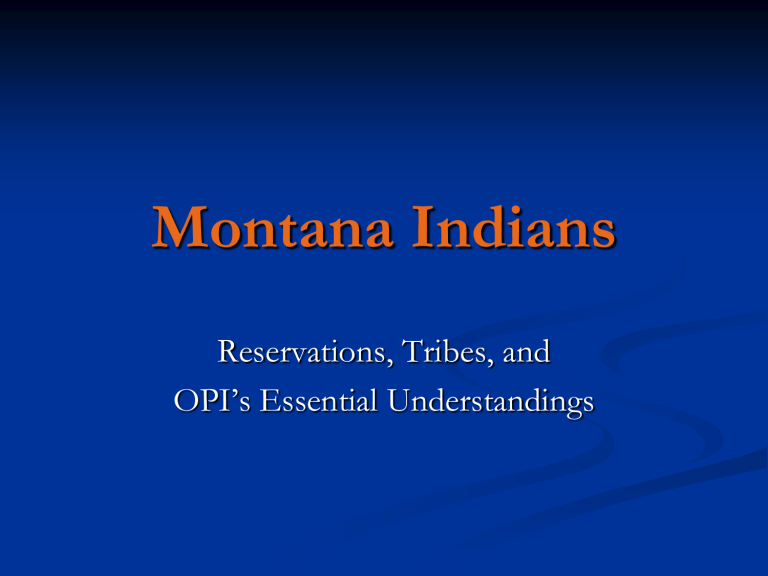
Montana Indians
Reservations, Tribes, and
OPI’s Essential Understandings
Montana has seven reservations: Blackfeet, Crow, Flathead,
Fort Belknap, Fort Peck, Northern Cheyenne, Rocky Boy’s
What is a reservation?
Essential Understanding #4:
Reservations are lands that have been reserved by the tribes for their own use through treaties and were not “given” to them.
The principle that land should be acquired from Indians only through their consent with treaties was based on three assumptions: a. that both parties to treaties were sovereign powers b. that Indian tribes had some form of transferable title to the land; and c. that acquisition of Indian lands was solely a government matter not to be left to individual colonists.
Blackfeet lands in Montana 1855-74
Background
Indian Nations located in Montana
Territory prior to the passage of the Montana Constitution in 1889, held large land bases as negotiated through their treaties with the U.S.
The treaties assigned tribes to certain areas and obligated them to respect the land of their neighbors.
However, the mining invasions of the 1860’s disrupted these areas as miners and others rushed into the prime gold fields that often lay within or along the designated tribal lands. The new inhabitants demanded federal protection; thus beginning the garrisoning of
Montana and the eventual relocation of the tribes to smaller and smaller reserves.
The federal government and
Montana citizens did not understand the lifestyles of
Montana’s Indian tribes and therefore dealt with them from the non-Indian point of view and expectations.
However, the federal government did understand that these tribal groups were sovereign nations and they needed to enter into treaty negotiations with them.
Reservation Date Established Names of Tribes
Blackfeet (Browning) Blackfeet
Crow (Crow Agency)
Flathead (Ronan)
1851
1851
1855
Crow
Fort Belknap
(Ft. Belknap Agency)
Fort Peck (Poplar)
1888
Confederated Salish,
Kootenai,
Pend d Oreille
Assiniboine and
Gros Ventre
Assiniboine and Sioux 1888
1884 Northern Cheyenne Northern Cheyenne
(Lame Deer)
Rocky Boy’s
(Rocky Boy Agency)
1916 Chippewa and Cree
Before we begin our tour…
…we’ll need some more background information about Montana’s Indian Nations…
The following information is based on Montana
OPI’s Essential Understandings regarding
Montana Indians and the OPI publications
Indians 101: Frequently Asked Questions and
Montana Indians: Their History and Location
Tribal Sovereignty
Essential Understanding # 7:
Under the American legal system, Indian tribes have sovereign powers separate and independent from federal and state governments. However, the extent and breadth of tribal sovereignty is not the same for each tribe.
Background
Tribal sovereignty does not arise out of the U.S. government, congressional acts, treaties, or any other source outside the tribe. It’s important to remember that before colonization, Indian tribes possessed complete sovereignty.
Tribes are now classified as domestic dependent nations. As such, they have the power to determine their own membership; structure and operate their tribal governments; regulate domestic relations; settle disputes; manage their property and resources; raise tax revenues; regulate businesses; and conduct relations with other governments.
Tribal governments
Tribes have the inherent right to operate under their own system of government, and the relationship between tribes and the U.S. is one of sovereign nation to sovereign nation.
Tribal governments have diverse structures. Many have adopted constitutions, others operate under Articles of Association, and some still maintain traditional systems of government. The chief executive of a tribe is generally called the tribal chairperson, but may also be called principal chief, governor, or president.
Essential Understanding 3:
The ideologies of Native traditional beliefs and spirituality persist into modern day life as tribal cultures, traditions and languages are still practiced by many
American Indian people and are incorporated into how tribes govern and manage
their affairs.
Common Misunderstandings
To clear up some common misunderstandings, OPI published American Indians 101: Frequently Asked
Questions. The next slides are excerpted from that publication, the Essential Understandings and Montana
Indians: Their History and Location
Citizenship
Citizenship: American
Indians became citizens of the U.S. in 1924 and are also citizens of the state in which they reside.
Terminology: While the term
“Native Americans” came into usage in the 1960’s, most tribal groups in Montana refer to themselves as
“American Indian.”
Taxes
Both tribes and individual
American Indians pay taxes.
Individual American Indians pay federal income taxes, fuel and tobacco taxes. American
Indians who work on a reservation do not pay state income taxes—because that right is reserved to the tribes.
American Indians working off the reservation do pay state income taxes.
Maria Valandra, Blackfeet, is Vice President for Community
Development for Montana’s First Interstate Bank system.
Tribal lands held in trust by the federal government are not subject to property tax, just as U.S. forest service land is not, because states cannot tax federal lands.
This lack of a tax base is made up by the federal government.
Counties in Montana are given Payment in Lieu of Taxes money to offset the tribal tax exempt lands within their boundaries. K-
12 public schools within reservation boundaries are provided additional Impact Aid. (Impact aid is also provided to schools on military bases and other federal properties.)
Federal income
American Indians do not receive payments from the federal government simply because they have American Indian blood.
An American Indian person may receive distribution funds based on:
mineral or agricultural lease income on property that is held in trust by the United States
for compensation for lands taken in connection with government projects.
Some tribes receive benefits from the federal government in fulfillment of treaty obligations or for the extraction of tribal natural
resources, a percentage of which may be distributed as per capita among the tribes’ membership.
Federal Indian Trust Responsibility
The Federal Indian Trust Responsibility is a legal obligation, upheld in numerous
Supreme Court cases, under which the
U.S. has charged itself with moral obligations of the highest responsibility and trust toward American Indian tribes.
The federal government is obligated to protect tribal lands and resources; protect tribes’ rights to self-government; and provide social, medical, educational and economic development services necessary for the survival and advancement of tribes.
Snake Butte, Fort Belknap Reservation
Treaty Rights
From 1777 to 1871, U.S. relations with individual American
Indian nations were conducted through treaty negotiations.
These contracts created unique sets of rights for the benefit of each of the treaty-making tribes and the U.S. government.
Those rights represent the supreme law of the land under the
U.S. Constitution. Treaties exchanged tribal land for certain protections and benefits, commonly including, among other things: hunting and fishing rights that may extend beyond reservation boundaries education of tribal children protection from the state by the federal government first priority water rights.
Education: College
Tribal colleges exist on each of the reservations in
Montana.
American Indians do not receive a free college education. Montana has a fee waiver for American
Indian students, but it is based upon financial need and only covers certain costs.
College bound American
Indian students fill out financial aid forms just like any other student.
Public Schools
Public schools began to operate on Indian reservations in Montana in the early 1900’s, and Indian students began to enroll almost from the beginning.
The curriculum offered limited information on the local Indian culture, history and traditions of the local tribal groups, and it did not encourage participation from local tribal government officials in its decisionmaking. This trend is now beginning to change.
Elementary School at Rocky Boy Agency
Essential Understanding 5
There were many federal policies put into place throughout American history that have impacted
Indian people and shape who they are today.
Much of Indian history can be related through several major federal policy periods, such as:
Colonization Period
Treaty Period
Tribal Reorganization
Termination
Allotment Period Self-Determination
Boarding School Period
Essential Understanding 6:
Ledger art at the Bighorn Battlefield offers another perspective on the history of the battle
History is a story and most often related through the subjective experience of the teller. Histories are being rediscovered and revised.
History told from an Indian perspective conflicts with what most of mainstream history tells us.
Background: Much of our history has been told from one perspective. It has been only recently that American
Indians have begun to write about and retell history from an Indigenous perspective.
Reservations in Montana: A Tour
There are twelve tribal Nations in
Montana…
Assiniboine (Nakoda)
Blackfeet (Pikuni)
Chippewa (Anishinaabe)
Cree
Crow (Apsaalooke)
Gros Ventre (White
Clay)
Kootenai (Kutanaxa)
Little Shell Chippewa
Pend d’ Oreille (Qaeispe)
Northern Cheyenne
Salish (Selin)
Sioux (Dakota)
Essential Understanding 1
…and there is great diversity among them, in their languages, cultures, histories, and governments. Each
Nation has a distinct and unique cultural heritage that contributes to modern Montana.
Essential Understanding 2:
There is a great diversity among individual American
Indians, as identity is developed, defined and redefined by many entities, organizations, and people.
There is a continuum of
Indian identity ranging from assimilated to traditional and is unique to each individual.
There is no generic American
Indian.
So, it’s important to remember that not only is there a great diversity among tribes but that there is also great diversity within tribes.
Blackfeet Reservation
Home to the Blackfeet
Total number of enrolled tribal members 15,118 :
8, 485 live on the reservation
Lands
Total acres: 1,525,712
311,174.98 tribally owned; the rest individually allotted, government, fee title or state lands
Communities
Browning, East Glacier, Babb, St.
Mary, Starr School and Heart Butte
College: Blackfeet Community
College
Crow Reservation
Home to the Crow
Total number of enrolled members: 10,333:
7,153 live on the reservation
Lands
Total acres 2,464,914
Tribally owned lands 404,272; the rest individually allotted, government, fee title or state lands
Government and Cultural
Districts
Reno, Ledge Grass, Pryor, St.
Xavier, Wyola, and Black Lodge
College: Little Bighorn College
Flathead Reservation
Home to the Salish, Kootenai and Pend d’Oreille
Total number of enrolled members: 6,961
4,244 live on the reservation
Land
Total acres: 1,243,000 acres
613,273 are tribal trust lands; the rest are tribal fee, individual trust, water, federal, state, town sites or fee land
The Salish,Kootenai and
Pend d’Oreille people are the minority population on their own reservation, although they now own 56% of their land.
College: Salish Kootenai College
Fort Belknap Reservation
Home to the Gros Ventre and Assiniboine
Total number of enrolled members:
7,303
5,771 live on the reservation
Land
Total acres: 645,576
210,954 acres are tribally owned, the rest are individual allotments, fee title or state lands or government lands.
9,000 acres are non-Indian owned
College: Fort Belknap Community
College
Fort Peck Reservation
Home to Nakoda
(Assiniboine), Dakota and
Lakota (Sioux)
Enrolled Sioux members: 6,969
Enrolled Assiniboine: 4,209
Close to 1,000 members of other tribes
Land
Total acres: 2,093,124
413,020 is tribal acreage, the rest is individually allotted, fee simple or state acreage
College: F t Peck Community
College
Little Shell Tribe of Chippewa
Morony Dam site, outside Great Falls
No reservation, but Morony Dam site pending
Total number of enrolled members
3,850
Many unenrolled Little Shell people in Montana
The Metis number thousands in the U.S. and south central Canada
Still waiting a ruling on federal recognition
Populations concentrations in
Great Falls, Havre, Lewistown,
Helena, Butte, Chinook, Hays,
Wolf Point, Hamilton, and Billings.
Northern Cheyenne
Home to Northern Cheyenne
Total number of enrolled members approx.
7,374
4,199 live on the reservation
Land
Total acres: 444,774.50 acres
326,546.81 acres are tribally owned, the rest are individual allotments, or fee title or state lands
Non-Indians own about 30 percent of the fee or state lands on the reservation; the tribe is looking to purchase more land.
Five Districts: Busby, Lame Deer,
Ashland, Birney, and Muddy
Rocky Boy’s Reservation
Home to the Chippewa and Cree
Reservation established by executive order in April of 1916, the smallest and last reservation to be established in
Montana
Total population of reservation approx. 5,000 number of enrolled Chippewa Cree members 3,750
Land
Total acres 122,259
All of the acreage is held in trust for the entire tribe; it is unallotted
College: Stone Child College
Rocky Boy Agency
Montana Urban Indians
The term Urban Indian is sometimes confusing and complex, even among
Indian people themselves. Because of the divisions and disenfranchisement,
Indian people in Montana have been split into many communities, social structures, cultural groups and economic strata. This has resulted in reservation and off-reservation Indians, enrolled and non-enrolled Indians, treaty and non-treaty Indians, Indian reservations and Indian country, trust and non-trust lands, etc. This condition has sometimes caused strained relationships between the various groups and has led to confusion for young people.
Montana Wyoming Tribal Leadership Council
Most of the urban Indian populations were created after W.W.II, when the federal government embarked on a policy to terminate federal recognition and services to reservations, and then later, during the 40’s and 50’s, to relocate them to cities. This policy moved several hundred thousand
Indian people from reservations to cities.
Indian Education for All
Montana 1972 Constitution: “The state recognizes the distinct and unique cultural heritage of American Indians and is committed in its educational goals to the preservation of their cultural integrity.
In 1999, House Bill 528 became law: “Every
Montanan…whether Indian or non-Indian, [shall] be encouraged to learn about the distinct and unique heritage of American
Indians in a culturally responsive manner…all school personnel should have an understanding and awareness of American Indian tribes to help them relate effectively with American Indian students and parents…Every educational agency and all educational personnel will work cooperatively with Montana tribes…when providing instruction and implementing an educational goal.”
